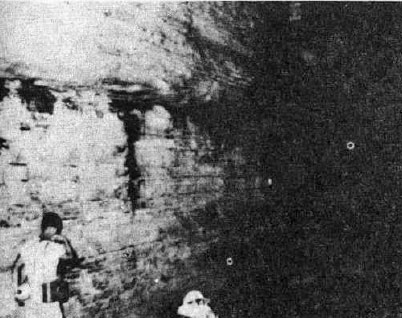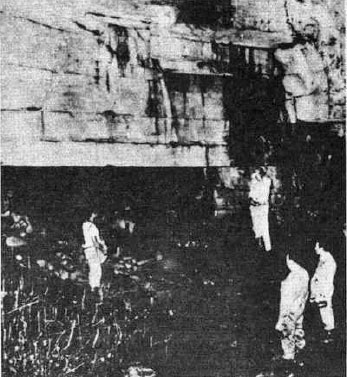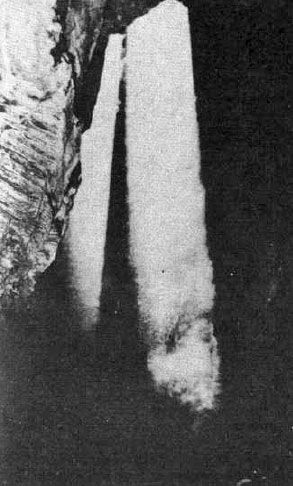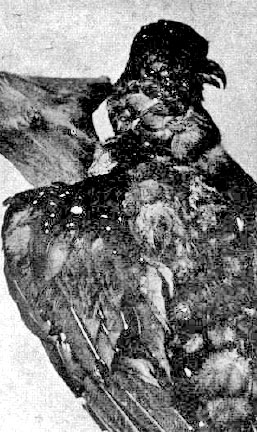|
So God ordered the mighty archangel Gabriel to destroy Lucifer and the rebels with a flaming sword.
The reader will find descriptions of events and prophecies that have been preserved in chapters i-xxv of the Prophet Isaiah (740-701 B.C.). Isaiah 14:12, says:
But we also find an unmistakable reference to strife in heaven in the New Testament. Revelation 12:7- 8, reads:
Many of the ancient documents of mankind mention wars and battles in heaven. The Book of Dzyan, a secret doctrine, was preserved for millennia in Tibetan crypts. The original text, of which nothing is known, not even whether it still exists, was copied from generation to generation and added to by initiates. Parts of the Book of Dzyan that have been preserved circulate around the world in thousands of Sanskrit translations, and experts claim that this book contains the evolution of mankind over millions of years.
The Sixth Stanza of the Book of Dzyan runs as follows:
In the Egyptian Book of the Dead, that collection of texts which contained instructions for behavior in the hereafter and was placed beside mummies in the tomb, Ra, the mighty Sun God, fights with the rebellious children in the universe, for Ra never left the world-egg during the battle. The Latin poet Ovid (43 B.C. to A.D. 17) is naturally better known to posterity for his Ars amandi than for his collection of myths, the Metamorphoses.
In the latter, Ovid tells the story of Phaeton (= the shining one), who was once given permission by his father Helios, the Sun God, to drive the chariot of the sun. Phaeton could not control the chariot, fell through the sky and set the earth on fire. In Greek mythology the twelve children of Uranus (the personification of heaven) and Gaia (the personification of earth) play an important part. These twelve Titans were terrible children who used their tremendous strength to rebel against the established order, i.e. against Zeus, the king of the gods, and attacked Olympus, the abode of the gods.
Hesiod (circa 700 B.C.), an earlier, Greek colleague of Ovid’s, who recounts the ancestry of the gods and the origin of the world in his Theogony, tells us that the Titan Prometheus brought fire down to men from heaven after violent conflicts with Zeus. Zeus himself was forced to share world dominion with his brothers Poseidon and Hades after a bloodthirsty struggle. Referring to Zeus by his name of God of Light, Homer (circa 800 B.C. ) describes him as cloud-banger, thunder-powerful and combative, who had no scruples about using lightning when fighting his enemies and so deciding the struggle in his favor. Lightning as a weapon also occurs in the Maori legends of the South Seas.
This plural is mentioned by the monotheistic Moses on another occasion:
Helene Petrovna Blavatsky (1831-1891), who founded the Theosophical Society in London in 1875, wrote in The Secret Doctrine, a work in six volumes, published in 1888:
I suspect that several gods had a hand in the creation (= opening up) of the earth, as well as in the “creation” of man. The creation myth of the Quiche Mayas, the Popol Vuh, tells us how man was created:
The Indian people of the Mayas, whose rather sudden emergence into so-called history is dated to shortly after the beginning of the Christian era, at first lived a very primitive life in the forests, killing game with the most rudimentary weapons. Yet the myths of the Popol Vuh are supposed to date from this primitive stage.
How could phrases like the following have occurred to such primitive minds:
It all seems so contradictory and confused that it cannot be explained logically by existing theories. So I should like to stimulate new ideas with the following scenario. If there were wars in the universe, there must have been conquerors and conquered. The victors remained in undisputed possession of their own planet, but the defeated had to flee. They were forced to make for another planet at very short notice in a still intact spaceship.
The reserves of energy and food that can be carried in a spaceship last only for a limited time. So the victors had only a definite period, which they knew, in which to wipe out and annihilate the enemy. The smallest advantage of time helped the defeated, because they could profit by time dilatation in their spaceship. (This phenomenon is scientifically proved. In a spaceship traveling just below the speed of light, time passes more slowly than on the launching planet, where it unfolds as usual.)
The victors wanted no survivors. If only a couple of survivors reached a safe haven, they would produce offspring and grow into a race which would take revenge for their defeat. (If one couple had a knowledge of molecular biology-and the victors knew this- they could even alter primitive life on the planet that was their goal.) The conquered knew the “mentality” of the conquerors and had the same technical know-how.
So in a race against time they steered for the nearest planet. Did the defeated find the third planet out from the sun, our earth, 28,000 light years from the center of the galaxy, after the war in the cosmos? Was our blue planet the refuge of the losers in a cosmic battle?
Supposing only each tenth planet to be of the size of the earth and possess the temperature range that makes it possible for life to originate and flourish, we are still faced with the inconceivable figure of 100,000,000! And even if we assume that only one in ten of these planets has a suitable atmosphere, we are still left with 10,000,000 planets with “putative” conditions for organic life.
Hans F. Ebel of Heidelberg University writes in his essay,
So my theory does not inevitably collapse for lack of sites for
launching ramps on earth-like planets. The hypertrophied opinion
which dominated our conception of the world until a few years ago
that the earth alone could support intelligent life has vanished
from even the most rigid academic circles. Tempi passati.
And, according to Professor Heinz Haber:
Lord Kelvin of Largs (1824-1907) was Professor at Glasgow University. In the natural sciences he had a great reputation as a physicist, for not only did he discover the second law of thermodynamics, but he also gave a strictly scientific definition of absolute temperature, which is measured in Kelvin degrees today. In addition, Kelvin discovered standard formula for the length of oscillations in electric oscillatory circuits and the thermo-electric effect named after him. As clearly emerges from these brief biographical data, Lord Kelvin was an important figure in the exact natural sciences; he is held up to students as one of the really great men in his field.
But nowadays we do not hear anything about Kelvin’s conviction that in the very beginning “life” did not originate on earth, our tiny planet, but came wafting from the remote depths of the universe in the form of spores. Kelvin was convinced that these unicellular vegetable spores-asexual germ cells, from which new life could originate-were so resistant to the intense cold that they landed on earth still capable of creating life, together with meteors or meteoric dust, and developed under the life-giving power of light so that finally higher organisms could emerge from them.
I advocate taking the whole Kelvin seriously, including the man who so many years ago rejected the arrogant assumption that life could only have originated on our planet. Even in these realms, which strictly pertain to natural science, we constantly come across the limits imposed by religious (= orthodox) thought. As life is finite, it must also be finite in the universe. Until natural scientists have proved that this conviction of Kelvin’s is false, they should give it a privileged place in the broad spectrum of opinions about how life originated on earth. The noble Lord has earned that much.
Nonsense, I am told. If equipment like that used today could be confirmed in such early* times, the alien intelligences must have developed quite differently from ourselves. I never hear precise arguments but what must not be cannot be. Amid the vast sea of speculations there are some logical conclusions that give quite solid support for my theory that alien intelligences must have been the same as homo sapiens, or very like him.
Puccetti shares his opinion that intelligent! beings throughout the universe must be more or less like homo sapiens with other eminent natural scientists.
The “proof can only be a logical sequence of con-elusions based on demonstrable facts. Professor Puccetti starts from the premise that similar external conditions lead to the formation of similar forms and organs in genetically different beings. This tendency exists on all earth-like planets where suitable conditions for complex forms of life occur. Therefore the differences in the evolution of beings that originated on our or any other planet should be minimal.
For in all cases life began with the chemical transformation of the surface of the planet - “with the appearance of organic matter from inanimate matter on the basis or carbon com-pounds in a water medium.” It has been proved that herbivores and carnivores became differentiated in their oceanic environment and developed special forms “before they conquered terra firma.”
Fossils have not only been found in rock with an age of 60,000,000 years, but also in slate a billion years old. The development of new kinds of bodies by formerly amphibious creatures was not a chance one. They needed different limbs in order to move about quickly on terra firma. Nature developed walking, which is the only sensible form of loco-motion, because it is possible on any surface. Whereas amphibious creatures still had small brains, land creatures needed a larger thinking apparatus, because the dangers from their environment multiplied. But the larger brain was easier to carry and supply with blood in a walking position.
Actually, fossil finds are clear proof that in the course of millions of years evolution steadily allowed the number of legs to atrophy, until finally two pairs proved to be the most suitable.
It is illuminating that the transition from amphibious to terrestrial Life necessitated such an alteration of the “chassis.”
These two locations proved to be the most suitable for feeding and excreting in the case of hunting animals (and not only in their case!). In all beasts of prey the most important sensory organs and prehensile limbs are at the foremost part of the body near the muzzle. So it is no wonder that the brain, the biggest bundle of nerves, is also located there, for then orders from the brain can travel to the prehensile organs by the quickest route.
Growing up on terra firma initiated a refinement of the nervous system that gradually produced the ability to formulate ideas.
As the use of even the simplest tools under water is “extremely difficult, it is,
Professor Puccetti also excludes the possibility that intelligent beings elsewhere could be bird-like, be-cause flying creatures must be light, whereas a large brain is heavy and needs a copious supply of blood. He mentions these variant forms of life to lead fantastic speculations about evolution back to more realistic lines of thought.
This evolutionary path must have been prescribed for intelligent life on all the other planets. Moreover these developments in the universe have been so numerous, says Puccetti, that attempts to contact intelligent extra-terrestrial beings and communicate with them “would not be doomed to failure.”
He continues:
The circle closes.
Lord Kelvin suspected that the first form of life on our planet “drifted” over” from the universe! Puccetti adduces from established knowledge about the origin of all life that the laws of evolution were and are the same everywhere. Joseph Kraut is convinced that nature on other earth-like planets must have solved its problems in the same way as it did in our case.
And Albert Einstein said that he wondered if nature did not always play the same game.
The rival parties in the cosmos had the same mathematical knowledge, the same standard of experience and shared a common stage of technological development. The defeated party, having escaped from the battle in a spaceship, had to make for a planet similar to their home, land there and organize a civilization (in the absence of an existing one). They knew how great the danger of being located from the cosmos was and that the victors would use every kind of technical aid to seek them out. A game of hide-and-seek began, but a game in which their survival was at stake.
The newly landed astronauts went underground. They dug themselves in, created subterranean communication routes over great distances and built strong points deep under the earth that afforded them safety, although they could emerge from them to cultivate areas of their new homeland and include them in the plans for a carefully thought out infrastructure.
As Der Spiegel related, the first test-model bored almost soundlessly through blocks of stone 12 feet thick. At Los Alamos they are now planning the construction of a thermal drill that is powered by a mini atomic reactor and eats into the earth like a mole, in the form of an armored vehicle. This drill is intended to pierce the earth’s crust, which is about 25 miles think, and take samples of the molten magma that lies underneath it.
The American firm of Westinghouse has developed an electron ray generator for welding experiments in space. The electron ray is especially suitable for blasting rock, because the hardness of “the rock is no obstacle to it. If an electron ray meets rock, it rips the thickest blocks apart by thermal tensions. Did the tunnel makers possess a combination of thermal drills and electron ray guns?
It is perfectly possible. If the drill came up against some exceptionally hard geological strata, these could be blasted by a few well-aimed shots with the gun. Then the armored thermal drill would attack the resulting blocks and heat the mass of debris to the liquid state. As soon as the liquid rock cooled down, it would form a diamond-hard glaze. The tunnel system would be safe against infiltration by water, and supports for the chambers would be superfluous.
Fig. 27. Juan Moricz claims that the long passages have glazed walls and that explosives were used to blast out the big halls.
A tunnel entrance 360 feet below ground level. Neatly blasted layers of stone are as clearly I recognizable as the right-angled door “shot” into the rock.
The pieces of stone (right) placed as in normal house-building cannot have originated naturally. When it was being built, it must have been higher. An inrush of water at some time caused a fall of rubble.
Swarms of buzzard-like birds (Fig. 30) leave the dark labyrinth through these shafts, coming and going all day long, and finally returning to die in the dungeon.
Fig. 29 One regularly comes across artificial ventilation shafts like this.
They are 5 feet 10 inches to 10 feet long and 2 feet 7
inches wide.
The number of buzzard-like birds living in the underground tunnels is legion. They are constantly coming in and out of the ventilation shafts, but finally return to the labyrinth to die.
It was here, in the impenetrable depths, that the “gods” decided to create men “in their image,” many years later, when they were no longer afraid of being discovered. The Popol Vuh, the sacred scriptures of the Quiche Indians, a branch of the great Maya family that lived in Central America, tells us about this “creation”:
And now comes the passage from the Popol Vuh already quoted. I cannot resist quoting it again in this connection, because of its astonishing contents:
A cuneiform tablet from Nippur, the town in Central Babylonia which was the seat of the Sumerian god Enlil in the third millennium B.C., has this account of the origin of man:
Here it might be objected that the parallels between the text of the Popol Vuh and the cuneiform inscription from Nippur are somewhat far-fetched, for it is about 8,000 miles as the crow flies from Central America, the homeland of the Mayas, to the fertile crescent between the Euphrates and the Tigris, the home of the Sumerians! But this is no carefully selected parallel from two cultural entities widely separated in space and time.
It is well known that the Old Testament, especially the Pentateuch, contains a good many Sumerian concepts. What is not so well known is that the Old Testament and the Popol Vuh also have just as many obvious features in common, and even more hidden ones.
Let skeptics compare the following passages:
The reader is entitled to ask what this detour taking in a Sumerian cuneiform inscription, the Old Testament and the Popol Vuh has to do with my tunnel builders. I am trying to produce arguments for my conviction that in the very beginning there was only one source of the origin of homo sapiens, namely the spacemen who first made the mutation.
Only much later, when peoples and races had settled in other parts of the globe, were new experiments in new places introduced into the first primordial tradition. But the core of the act of creation, namely that the gods created the first men in their own image, is preserved in all the worldwide traditions! The creation of man by extraterrestrial intervention does not interfere with the theory of our ancestry or the theory of evolution.
Now there are two questions. Firstly, what event set off the process of becoming man? Secondly, why did homo sapiens alone of all the kinds of hominids become intelligent? There are many answers, but none of them is convincing. About a million years ago all hominid types of ape had a brain capacity of about 25 cubic inches. If the climate drove the apes down from the trees during the following millennia, that must have included all kinds of apes and not just the one which was selected to produce homo sapiens.
But if the ability to produce tools had been a prerequisite for development and further evolution, there should not really be any apes left today.
With regard to the problem of the origin of man, Maerth puts exciting questions like this:
There is really nothing in the theory of
evolution to explain the mighty leap by which homo sapiens set
himself apart from his family of hominids. All we hear is that the
brain suddenly became efficient, acquired technical know-how, was
capable of observing the heavens and establishing communication in
social communities. In terms of the history or evolution this leap
from animalistic being to homo sapiens took place overnight. A
miracle? Miracles just don’t happen.
Professor Leakey of the National Research Center for Prehistory and Paleontology, Nairobi, refers to finds near Fort Ternan, which showed that Kenyapithe-cus Wickeri produced edged tools and that homo habilis used simple tools two million years ago. Leakey also tells us that Jane van Lavich-Goodall investigated chimpanzees in their natural surroundings and established that these distant cousins of man regularly make and use a variety of simple tools. Who is willing to admit these chimpanzees, which meet the criteria for membership of homo sapiens, into the circle of intelligent human beings?
So I hazard the claim that the vanquished in a cosmic battle first set the process of becoming man in motion with their knowledge of the genetic code by means of an artificial mutation. On June 5, 1972, the Associated Press, Washington, distributed a news item on the 129-page report of the Committee for Astronomical Research of the American Academy of Science.
In the view of these scholars the probability of intelligent extra-terrestrial civilizations existing in the universe has increased considerably during the last seven years. The Academy recommends that attempts by astronomers to discover such distant worlds with intelligent inhabitants should be supported by large government subsidies.
Admittedly existing telescopes could already receive radio signals from extraterrestrial civilizations, but new instruments must be developed capable of picking up signals from inhabited heavenly bodies outside our solar system as well.
The committee’s report says literally:
Insofar as one can produce indications in support of a theory, I think one should introduce them into a serious discussion. It is not a question of asking for proofs. What scientific theory could be built up on proofs from its first conception?
Should he or must he believe in scientific theories
even if the results of Research finally show them to be wrong? I
want to stimulate thought with my theories. No more, but also no
less. And here I have put forward my new theories, stimulated by
indications of how the tunnels in Ecuador and Peru could have
originated and when homo sapiens may have celebrated his “birth
hour.”
|



